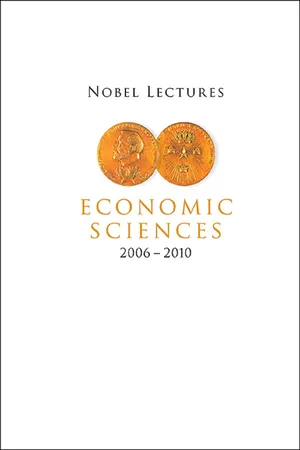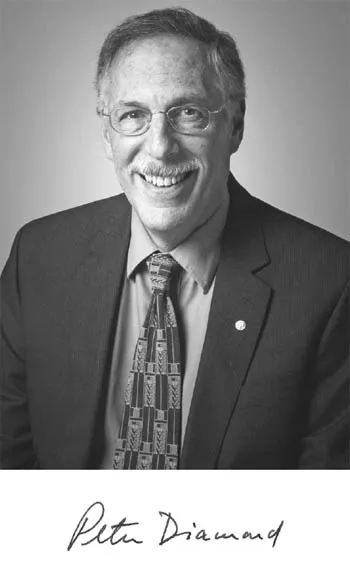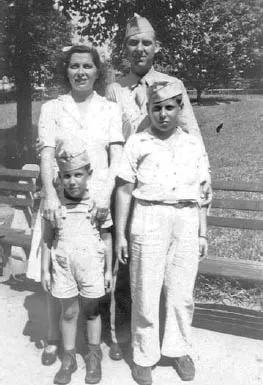![]()
Economic Sciences 2010
Peter A. Diamond, Dale T. Mortensen and Christopher A. Pissarides
“for their analysis of markets with search frictions”
THE SVERIGES RIKSBANK PRIZE IN ECONOMIC SCIENCES IN MEMORY OF ALFRED NOBEL
Speech by Professor Bertil Holmlund of the Royal Swedish Academy of Sciences.
Translation of the Swedish text.
Your Majesties, Your Royal Highnesses, Honoured Laureates, Ladies and Gentlemen,
In the economic sciences there is a classic view of the market as a place where a large number of buyers and sellers meet and can trade with each other. They find each other without cost and have full information about the prices of all goods and services. Prices are determined in such a way that supply will equal demand. In this equilibrium, both buyers and sellers are “satisfied”, in the sense that they can carry out the transactions they are looking for.
But many markets do not work this smoothly. It often requires time and effort for a buyer and a seller to establish contact and reach agreement on the terms of a transaction. In the labour market, such search frictions result in the simultaneous occurrence of unemployment and job vacancies. It takes time for job seekers to find work, and firms can typically not fill their vacancies immediately.
Peter Diamond, Dale Mortensen and Christopher Pissarides have developed a theory of markets with search frictions. This theory is relevant in many markets. For example, it applies to the housing market, where many households are searching for new homes at the same time as a large number of houses and flats are being offered for sale. Search theory can also be used to study how spatial frictions and transport costs affect residential patterns and business location decisions, and even how matching takes place in the marriage market. However, the most important application is in the labour market.
The Laureates have shown that price and wage formation in a search market may sometimes lead to outcomes that are radically different from what we would expect from conventional theory. They have also shown that resource utilisation in a search market is generally not socially efficient, since there are indirect effects that individual agents do not take into account. If one unemployed person increases her own search activity, it will become more difficult for other job seekers to find employment. At the same time, it will be easier for a recruiting firm to fill its vacancies. Since these indirect effects are not taken into account by individual agents, there is generally scope for government intervention aimed at achieving welfare improvements.
The Laureates’ model of the labour market characterises the search activity of the unemployed, the recruiting behaviour of firms and wage formation. The model can be used to study how the level and duration of unemployment, the number of job vacancies and the real wage are determined. For example, what role is played by the design of unemployment insurance, the efficiency of employment agencies and regulations on firing and hiring?
The effects of unemployment insurance have been extensively studied. The theory implies that more generous benefits bring about longer search time for the unemployed and higher unemployment − a relationship that has received support in many empirical studies. However, unemployment insurance can also facilitate efficient matching between job seekers and vacancies, so that the “right person” ends up in the “right place”.
But questions about how unemployment insurance should be designed can of course not be answered without also weighing in the fact that this insurance provides income protection to those who have been laid off. Search theory has also proved to be a highly useful tool for such welfare analyses of alternative designs of unemployment insurance.
Dear Professors Diamond, Mortensen and Pissarides,
Your research on markets with search frictions has had a profound impact on how economists view markets in general and labour markets in particular. You have provided detailed models of how prices and quantities are determined in markets with frictions and how frictions affect unemployment and other labour market phenomena. Your models have become indispensable tools for policy analysis and your work has initiated a large empirical literature.
It is an honour and a privilege to convey to you, on behalf of the Royal Swedish Academy of Sciences, our warmest congratulations. I now ask you to receive your Prize from the hands of His Majesty the King.
PETER DIAMOND
My grandparents immigrated to the U.S. around the turn of the last century. My mother’s parents and six older siblings came from Poland. My father’s parents met in New York, she having come from Russia and he from Romania. My parents, both born in 1908, grew up in New York and never lived outside the metropolitan area. Both finished high school and went to work, my father studying at Brooklyn Law School at night while selling shoes during the day. When they married in 1929, my mother was earning $15 a week as a bookkeeper and my father, $5 a week as a novice lawyer.
My brother, Richard, was born in 1934 and I in 1940. My father continued to practice law until his late 80s, but my mother had left the paid labor force by the time of my birth. She volunteered in a number of organizations after that, often serving as treasurer, drawing on her bookkeeper background. In more recent times, with better opportunities for women, she would have had a good career.
I started public school in the Bronx, and switched to suburban public schools in second grade when the family moved to Woodmere, on Long Island. Our house faced the Long Island Rail Road and was so close to the tracks that the family thought the first train at 5 AM was coming through the bedrooms.
Figure 1. Diamond with older brother Richard and parents, summer, 1944, Battle Creek Michigan, where his father was stationed.
After high school, I went to Yale. I have joked that I loved college and just never left. After considering a major in engineering, I chose math instead. I learned how to do a rigorous mathematical proof from Shizuo Kakutani, who taught the class in real analysis. He had proved a fixed-point theorem that plays a key role in some economic analyses.
In my second year at Yale, I took a year-long introductory economics course from Charles Berry. He interested me in economics and became a friend. In the following year, at Berry’s suggestion, I took the year-long intermediate honors theory class, taught by Ed Budd. This increased my interest in economics enough so that I broke off my study of French to take the graduate mathematical economics course taught by Gerard Debreu, based on his newly published Theory of Value. Debreu was an outstanding teacher, and my early and thorough grounding in general equilibrium theory has stood me in good stead ever since, shaping my thinking about economics. At the same time I was studying game theory in the seminar for senior honors math majors and graduate math classes in Algebra and Topology.
My first job as an economist (sort of) was as a research assistant for Tjalling Koopmans for the summer of 1960. I shared an office with T.N. Srinivasan and got to hang out in the Cowles Foundation, with its memorable coffee time discussions. I was hired to help with the mathematics. When asked to produce an example of a function with certain properties, I found it easier to produce a class of functions with the desired properties, rather than cranking out a single example. That led Koopmans to reorient his research plan, giving this class of functions a central role, and to promote me to co-author for my first publication (appearing in 1964). I had had no idea that the class of functions would be interesting, and have come to recognize that an important part of education is learning to recognize the value of what you stumble over, as well as choosing research topics with a sense of how valuable possible findings might be. I have always viewed this splendid economist and splendid person as a role model for how to do economics and how to relate to people.
In light of my interest in both math and economics, I applied to graduate schools in both subjects, but settled on the MIT math department. My plan was to take micro and macroeconomics and complex and real variables, deciding at the end of the year which was the better career route. But the complex variables class conflicted with both micro and macro. I decided to drop complex variables, figuring I could pick it up in the summer if economics didn’t hold me. The math graduate registration officer (GRO), George Thomas, who had written the calculus book I had learned from, thought I should be advised by the economics department. He simply transferred me (along with my fellowship) to the economics department and GRO Bob Solow. Bob promptly added statistics and economic history to my class load.
I enjoyed economic theory and didn’t enjoy real variables (and I was better at economics). It seemed to me that the real variables class was about proving the same theorem about integration over and over, in more and more general settings. I found the generalizations of no interest, perhaps because I was ignorant of what could be done with more general versions that couldn’t be done otherwise. As an economist, I have always been more interested in working on models generating new insights, and not much in generalizations, as important as they sometimes are. So my experimentation ended after one semester.
The public finance class, taught by E. Cary Brown, was, for me, a key part of the normal two-year course load. We worked through everything in the newly published The Theory of Public Finance by Richard Musgrave, an outstanding scholar who had written an exceptional book. Musgrave’s drive to put public finance on a general equilibrium basis was important for my development and fitted well with the general equilibrium orientation that I had acquired from the class with Debreu. This background played a central role in my later work on optimal taxation.
My thesis, supervised by Bob Solow, had one essay that took a different approach to the same questions I had worked on with Koopmans, and two essays in growth theory. One of them built on work of Srinivasan and one on work of Solow and of W.E.G. Salter, whose book Solow brought to my attention at a time when I was failing to find a topic for the needed third essay. Solow was and is an outstanding economist, a splendid person and a good friend. He has supervised a large fraction of MIT dissertations. He and Koopmans have been my role models. More generally, MIT was (and is) a terrific place to be a graduate student, to get an outstanding and broad education, while having a good time. And it has been a terrific place to be a faculty member. The students, both undergraduate and graduate, have provided stimulating teaching opportunities, both pleasurable and educational for me, and a series of outstanding research assistants. My colleagues, for whom I have always had the greatest affection and admiration, have functioned as a team, with open doors and profound interest in encouraging the students. They have kept me interested and informed over a wide range of economics topics, have helped with my research, including joint authorship, have joined in the smoothest running of a department one could imagine, and have been wonderful friends.
I landed a job at Berkeley as one of four new assistant professors who started in September 1963, having been recruited by Andy Papandreou, shortly before he returned to Greece. Among the four of us are three Nobel Prizes. In 1963–64, Berkeley was a perfect place to be a young theorist. The junior faculty interacted all the time, and became the best of friends. Particularly important for me were Dan McFadden, Bernie Saffran, and Sid Winter. The senior faculty were supportive. Together with Tibor Scitovsky, I taught the graduate micro-macro sequence (one semester of each). I also taught a year-long undergraduate public finance class, which had a prerequisite of intermediate theory. I taught public finance again the following year, along with money and banking. The theory prerequisite and the length of the public finance class allowed for a thorough exploration of topics, and introduced me to the experience of discovering results leading to good papers as part of developing material for a class of sharp, attentive students. My first such experience led to my 1965 paper on the public debt. While many are concerned about the tension between teaching and research, my experience is that they reinforce each other. Indeed, the times when I had the most difficulty in finding good research topics have occurred when I did little teaching.1
Berkeley was a great place for me at the time for more reasons than good teaching and research opportunities. Top of the list was meeting my wife Kate (real name Priscilla Myrick), a student in law school at the time I started teaching economics. Despite the fact that I was teaching public finance and she found taxation to be her least favorite class, there was enough attraction that we married in 1966, shortly after I returned to MIT.
Figure 2. Wedding photo, October 1966.
Berkeley also gave me the opportunity to witness the start of the student uprisings, with the Free Speech Movement of 1964. I watched the repeated mistakes of the Berkeley administration, mistakes repeated again and again by university administrations across the country. Being part of a faculty trying to help, but not succeeding much, was quite an education.
One of the pleasures of an academic career is the opportunity to visit places, for short times and, especially valuable, for long ones. My first year of leave was 1964-5, after just two years of teaching. I was an Overseas Fellow at Churchill College, Cambridge, an opportunity organized for me by Frank Hahn. Having Frank as a colleague was one of the prime attractions for going to Cambridge. Talking economics with him lived up to expectations, and we became good friends. Living in college, meeting scholars from an array of fields, spending lots of time in the economics faculty, and tutor...



